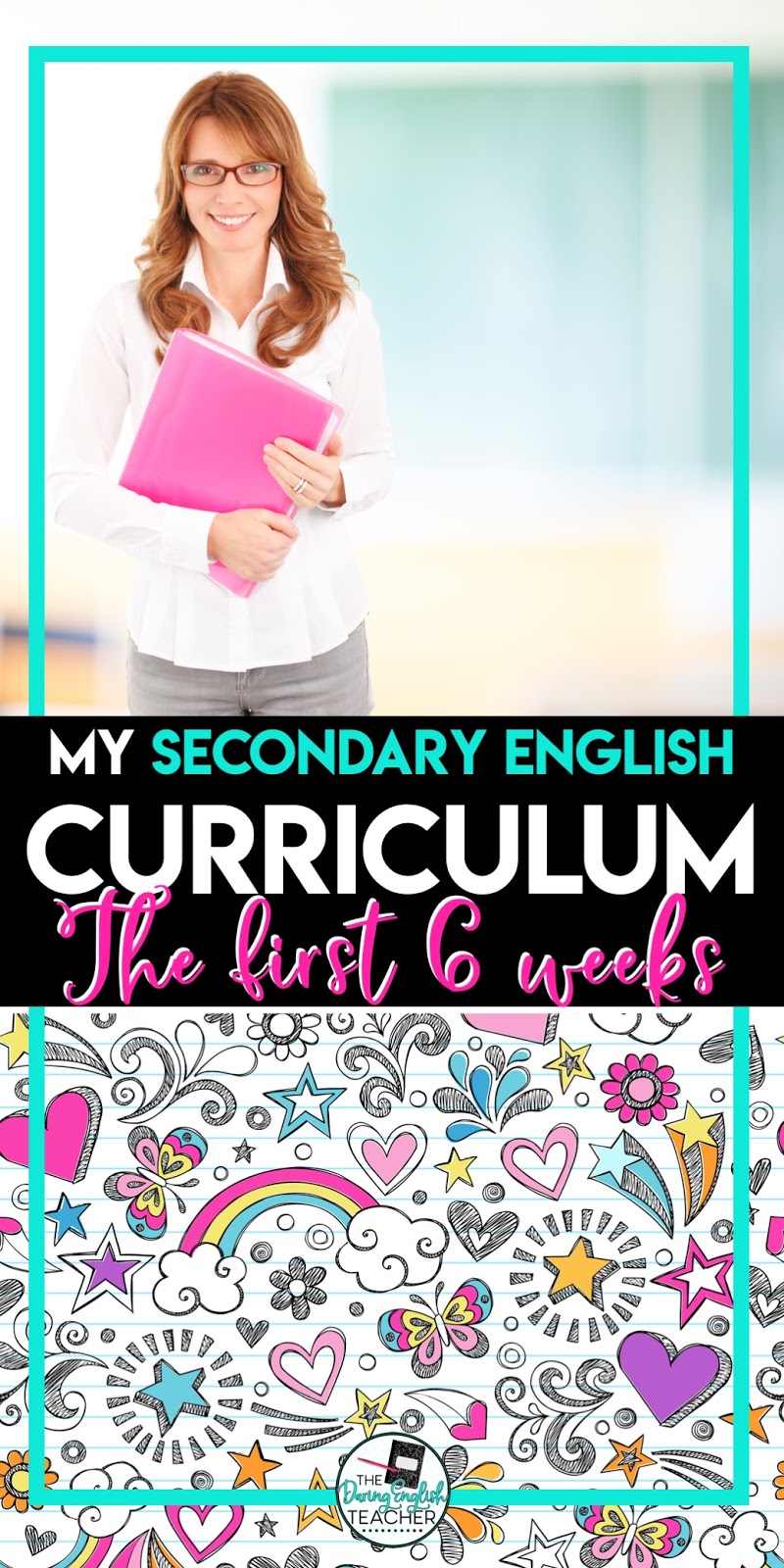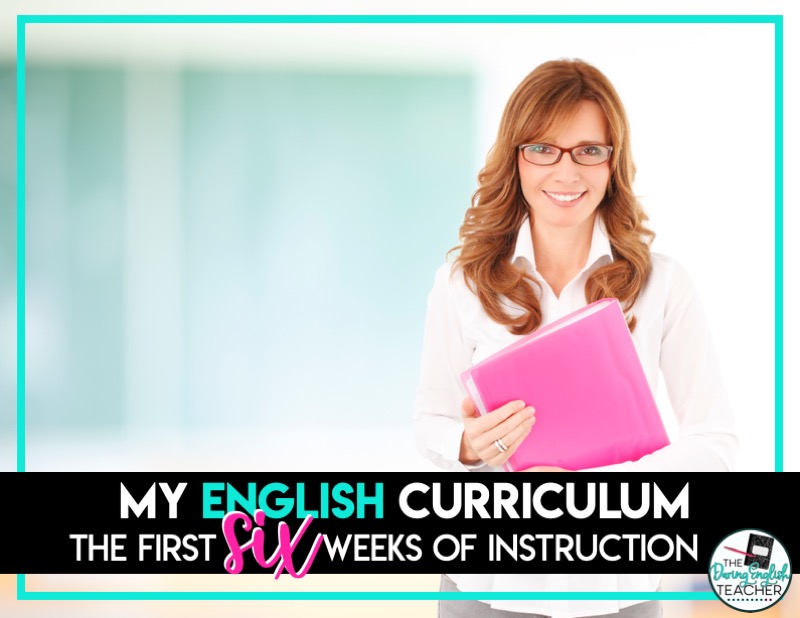Hey there, fellow English teacher! I want to share what my secondary English curriculum for the first six weeks of school looks like.
If you’ve stumbled upon this blog post, chances are you are looking for teaching ideas, inspiration, lesson plans, and guidance for teaching middle school ELA and high school English at the beginning of the school year.
Here’s a look at the first six weeks of instruction inside my high school English class.
Here is a look at the first six weeks of my Secondary ELA/English Curriculum
Week 1 of Secondary ELA
To begin with, I usually like to spend about three days getting to know my students and fostering a positive classroom culture. To do so, I use the resources in my Back to School Activities for Secondary Students and Growth Mindset Activities resources. Usually, by the third day, I like to begin assessing my students’ abilities, and this typically takes the form of a short narrative essay. I spend the last two days of the first week teaching students how to properly annotate text with my Annotating Text Made Easy lesson. I like to use this lesson at the beginning of the school year so that I can refer back to the close reading skills they gain during this lesson throughout the entire year.
Another great way to start out the school year is by doing a first day of school stations activity!
You can also check out this blog post about the 10 lessons and activities to teach when you go back to school!
Weeks 2-5 of Secondary ELA
For my first unit of the school year, I like to begin with short stories. Starting the year with short stories exposes students to literary devices and elements. For the first week of the short story unit, I typically begin with the shortest short story because there is some pre-loading that goes into this unit. Before we even read a short story in class, I teach students about short stories and literary devices using a PowerPoint lesson found in my Short Stories Unit. What I like about this unit is that it introduces students to the content, and it works with any short story. There are many organizers and creative assignments included in this resource as well.
When I teach short stories, I usually tend to focus on one or two literary elements and devices per story. Before we read, I give students vocabulary words, review important story context, and teach the focus literary element or device. Then we read the story, and I have them look for examples and quotes that show that particular device. After each short story, I have them write a paragraph that analyzes the short story, the author’s use of the device, and how the device contributes to the audience’s understanding of the story. I typically do not quiz my students on each short story, rather I assess their knowledge and understanding through these paragraphs.
One of my favorite short stories to teach is “The Most Dangerous Game.” This Close Reading Lesson and Writing Activity follows the format that I teach. It focuses on a particular literary device and includes a writing response. Since I teach short stories at the beginning of the year, I provide my students with sentence frames to help with the writing.
Going digital? I also like to engage my students in short stories at the start of a new school year with a digital short story literary analysis unit.
Week 6 of Secondary ELA
 I wrap-up my short story unit with a fictional narrative. Throughout the first few weeks my students read and analyzed narratives, so I like to conclude this unit with a narrative of their own. We spend a couple days brainstorming their protagonist, antagonist, setting, conflict, and plot structure. The students sketch out their narrative essay and write their first draft. After a day of revision circles (peer editing done in small groups), students then publish their final draft using the feedback from their peers. I use the information in my Narrative Writing Unit to help with this final assessment.
I wrap-up my short story unit with a fictional narrative. Throughout the first few weeks my students read and analyzed narratives, so I like to conclude this unit with a narrative of their own. We spend a couple days brainstorming their protagonist, antagonist, setting, conflict, and plot structure. The students sketch out their narrative essay and write their first draft. After a day of revision circles (peer editing done in small groups), students then publish their final draft using the feedback from their peers. I use the information in my Narrative Writing Unit to help with this final assessment.
On the last day of the unit, I typically assess my students with an end-of-unit test that includes all of the literary devices we covered and information from each of the stories. I also use this time in class while students are testing to begin grading their final drafts. Doing this helps reduce the time I spend on the weekends grading student papers.
After teaching short stories for the first unit, my students are ready to move on to a longer text! If you are looking for a more in-depth look at how I plan my secondary English curriculum, here’s a look at my year-long English pacing guide.



9 Comments
Thank u! So helpful!!
You are welcome! I plan to publish a post like this for the entire year!
Have you posted more on the rest of your curriculum? We are currently working on writing our curriculum and I'm searching out all the examples I can find!
Hi Mrs. Barnoskie. As of right now I have not posted more weeks. I hope to work on the entire curriculum over summer. Thank you for reading.
Thank u! So helpful!!
You are welcome.
I love this first 6 weeks calendar! I do have a question–Do you see your classes everyday or every other day? I want to implement something like this for next year, and I am just trying to get timing down. Thanks!!
Hi Ashley. I have my classes every day for about 55 minutes each period.
Hi Christina, I'm a first year ELA teacher and I can't tell you how inspiring and helpful you've been. I follow you on instagram and TpT and it's helped me out so much. My middle school students just finished the writing portion of their FSA (Florida Standards Assessment) and they all went in to take their test with confidence in their abilities. I cannot tell you how happy that made my teacher heart. Thank you for sharing these great resources!